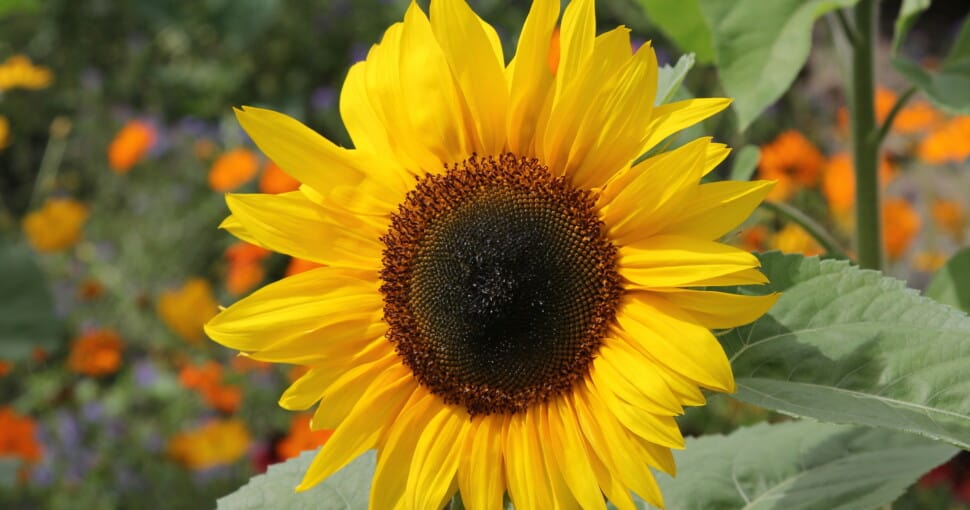The sunflower (Helianthus annuus) is part of the Asteracea family of plants which contains more than twenty-five thousand species, and sunflowers account for roughly seventy of these species. When speaking about sunflowers, most people think about a large golden-colored flower grown for its nutritious seeds and oil production.
Contents
What is referred to as a sunflower is, in fact, a compound flower made up of as many as two thousand small flowers. The brightly colored outer flowers are called ray flowers, while the less colorful flowers in the center of the sunflower head are called disc florets. To form a seed, each one of these disc flowers needs to be pollinated. The ray flowers do not produce seeds as they are sterile.
These beautiful plants don’t only provide us with seeds. Sunflowers are also planted to remove toxins like nuclear waste from the soil, while some varieties, like the Jerusalem Artichoke, provide tubers for food.
Within this large family of flowers, there are several categories of sunflowers. The large sunflower varieties grown for food and oil form part of the giant sunflower category. They certainly can live up to this name, with the tallest recorded sunflower measuring thirty feet in height.
Some other categories include double sunflowers like the teddy bear variety, perennial sunflowers, dwarf sunflowers, and many specialty varieties that differ from the traditional yellow-colored sunflowers. These colors can include red, white, pink, and variegated colored sunflowers.
With such a wide variety available, it is understandable that other plants can be mistaken for sunflowers.
1. False Sunflower
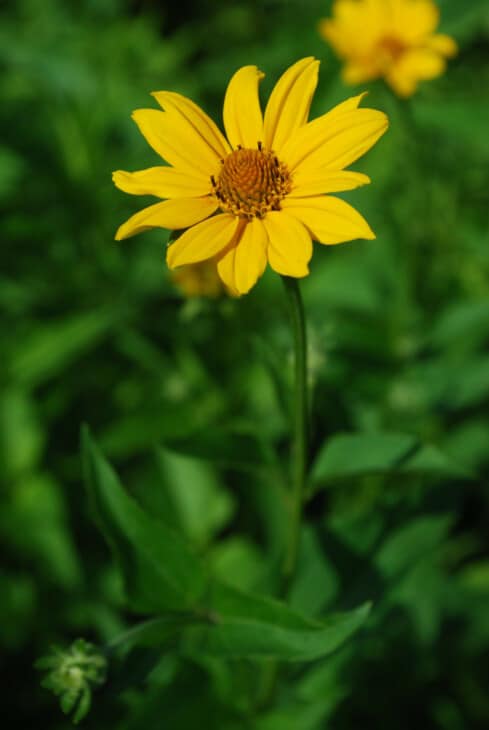
False sunflowers (Heliopsis helianthoides) also go by the names Rough oxeye and Heliopsis sunflower. These members of the Asteracea family can look very similar to sunflowers in the perennial and specialty sunflower categories. There are a few telltale signs to differentiate these plants, though.
The plant’s leaf shape is similar to that of sunflowers, and the leaves of both plants have serrated edges. There are ways to tell the plants apart, though. Sunflower plants have hairy leaves, while false sunflower leaves do not have hairs on their leaves.
When examining the flowers, most perennial sunflowers do not produce seeds as they propagate via their rhizomes. Specialty varieties of sunflowers will not produce seeds from the ray flowers. False sunflowers propagate via seeds produced from the ray flowers and the disc florets.
2. Black-Eyed Susan
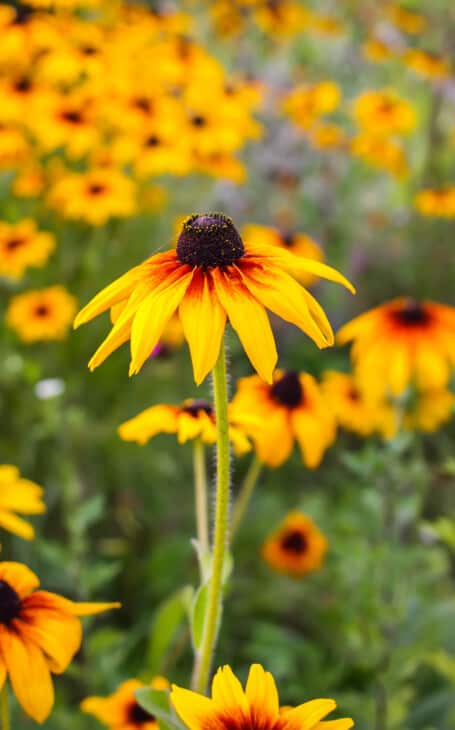
The black-eyed Susan (Rudbeckia hirta) usually grows as an annual plant in a shrub-like fashion similar to a perennial sunflower. Black-eyed Susan looks very similar to the Schweinitz’s sunflower. Like sunflowers, the black-eyed Susan can be found in many more colors than just yellow, adding to the confusion when trying to tell these plants apart.
The leaves of the black-eyes Susan are hairy like a perennial sunflower, but the leaf is more lance-like in shape when compared to a sunflower leaf that is much wider at the base and tapers into a sharp point. Black-eyed Susan leaves have a smoother edge than the serrated edges of sunflower leaves.
Rudbeckia also produces compound yellow ray flowers with dark brown to black disc flowers in the center. Newer varieties are harder to tell apart purely by color, as varieties like Rudbeckia Autumn colors can look very similar to sunflower varieties like The Joker, which has a similar plant shape and range of colors.
3. Yellow Coneflower
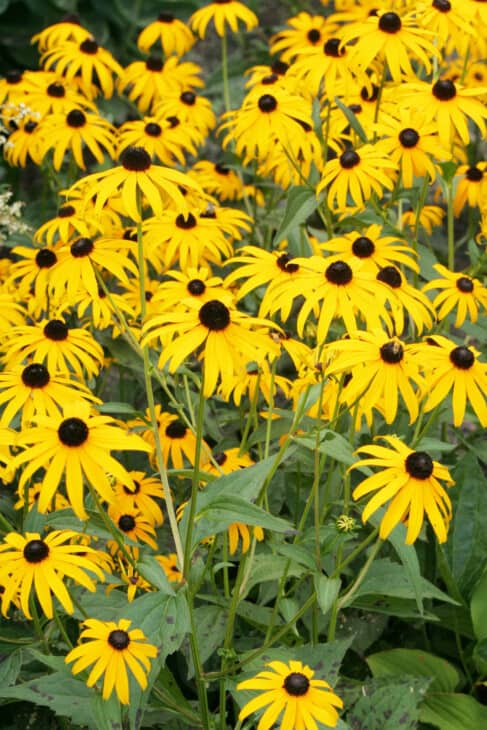
The yellow coneflower (Echinacea paradoxa) is a perennial plant in the Asteraceae family, and like sunflowers, it is native to North America. The flowers are very similar to the First Light sunflower variety, with bright yellow ray petals arranged around a dark center cone.
Yellow coneflowers may look like perennial sunflowers, but the plant growth pattern is very different. The leaves grow from a central point and are long and lance-shaped. First Light sunflowers have needle-like leaves that cover the flower stem as well.
The coneflower bears a single flower on a long leafless stem, unlike the clusters of flowers formed by First Light sunflowers. The dark center of the cone flower is much harder and spikey than sunflower blooms. The cone flower produces seeds in the center cone, where the First Light sunflower reproduces by dividing the root.
4. Pink Coneflower
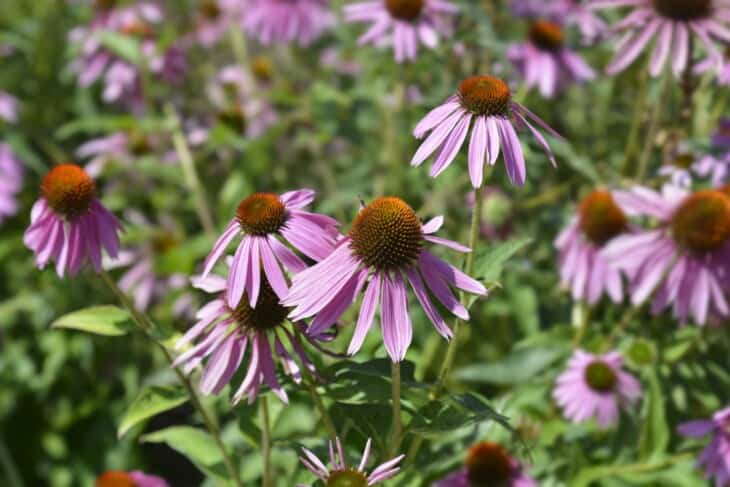
Pink coneflowers like Echinacea purpurea Maxima seem like an unusual plant to mistake for a sunflower, but not all sunflowers are yellow. Pink sunflowers varieties like Black Cherry sunflowers, Mrs. Mars sunflowers, and Midnight Oil are only a few of the pink varieties available.
Pink sunflower varieties all bear a single flower on a single flower stalk, similar to the pink coneflower. The echinacea flower structure is a compound flower, just like sunflowers, but the florets in the center stand out in a cone shape above the ray flowers. The center of the coneflower is also much smaller than the pink sunflower varieties.
5. Safflower
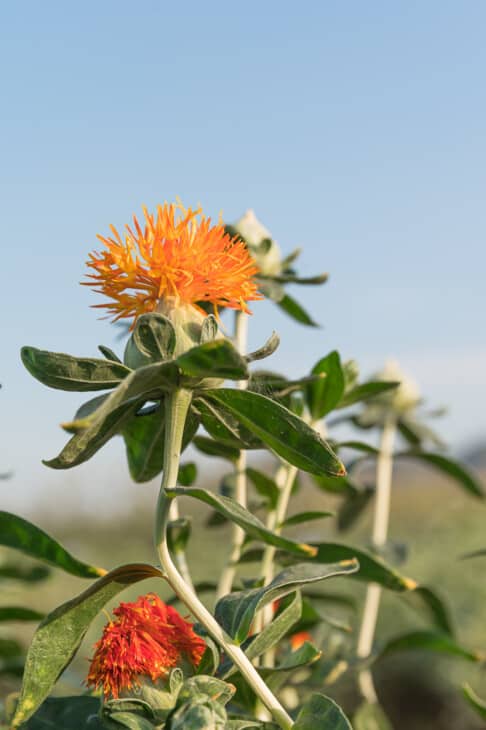
Safflower (Carthamus tinctorius) is an annual and belongs to the family Asteraceae. The safflower plant is grown for oil production, similar to sunflowers but produces far fewer seeds per flower than sunflowers. Typically, safflower will produce only twenty seeds per flower compared to almost two-thousand seeds in a sunflower.
The flowers of a safflower plant look somewhat like a teddy bear sunflower but smaller. Like the teddy bear sunflower, safflower plants form multiple side branches and can bear as many as fifty flowers on a plant.
The leaves of the safflower plant are oval to lance-shaped and smaller than the teddy bear sunflower leaves. The safflower leaf has spines and is toothed like sunflowers but lacks the hairs found on sunflower leaves.
6. Mexican Sunflowers
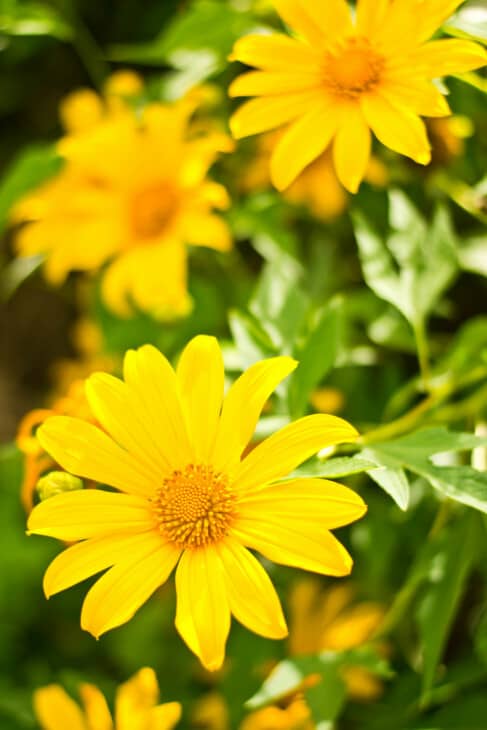
Mexican Sunflowers (Tithonia rotundifolia) are bright orange and have a similar color to the Little Becka sunflower variety. As the name rotundifolia suggests, the flower petals of the Mexican sunflower have a rounder shape than those of the sunflower ray petals but both types of plant bear compound flowers.
The Mexican sunflower grows as a large shrub with many side branches and produces a single flower on a flower stalk that protrudes from the bush. The Little Becca orange sunflower is a dwarf sunflower that forms many branches but does not grow taller than two feet high, unlike the Mexican sunflower, which can grow to six feet in height.
The leaves of Mexican sunflowers and Little Becka sunflowers look very similar. Both plants have leaves with a wider base than the tip, called a deltoid shape. Both plants’ leaves are serrated and hairy as well. Occasionally the Mexican sunflower leaf can present as lobed.
7. Giant Marigold
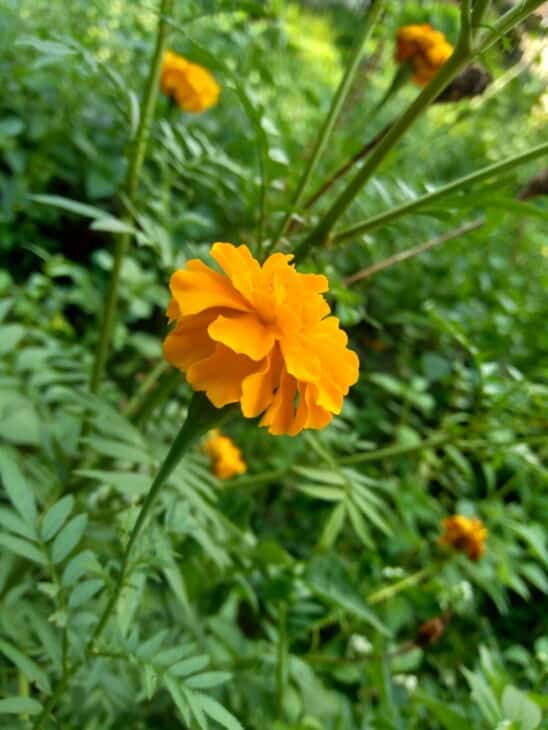
African Marigolds (Tagetes erecta), also called giant marigolds are native to Mexico but have become naturalized in most countries worldwide. The flowers resemble a teddy bear sunflower and can range in color from light yellow to deep orange.
Like the teddy bear sunflower, the marigold flower has a dense arrangement of ray flowers that results in a round pom-pom-shaped flower. Both these plants can grow to a height of around four feet with branched flower stems.
The flowers may be mistaken at a distance, but up close, the marigold flower has a distinct scent, and the leaf structure of the marigold is divided into feathery leaflets, which are very different from a sunflower leaf.
Related: Are Marigolds Poisonous?
8. Japanese Sunflowers
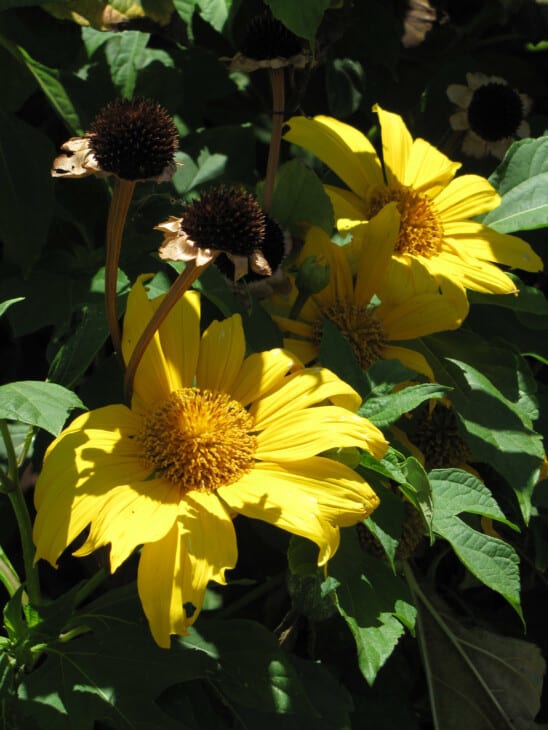
Japanese sunflowers (Tithonia diversifolia) are another member of the Asteracea. Plant family. Sometimes also called a tree marigold, this flower looks very similar to the Jerusalem Artichoke sunflower or sunchoke variety. The Japanese sunflower’s yellow to orange colored ray flowers are arranged around a yellow center of florets in the same way as a Jerusalem Artichoke.
Both these plants grow quite tall, reaching heights of nine feet. Both Japanese sunflowers and Jerusalem Artichokes plants form many side branches with many showy flowers carried on the ends of these branches.
Japanese sunflowers produce viable seeds, unlike sunchoke flowers which are sterile, as the plant reproduces via rhizomes and tubers. The leaves are another way to tell these two plants apart. Sunchoke leaves are deltoid in shape with a slightly serrated edge, while the Japanese sunflower has five-lobed leaves.
9. Blanket Flower
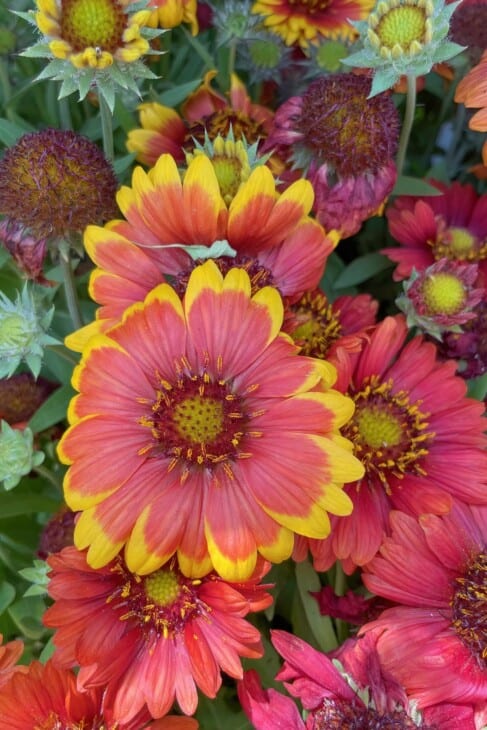
The blanket flower (Gaillardia pulchella) is native to North and South America, but it has become a common garden flower with thirty species of Gaillardia to choose from. Blanket flowers present a wide variety of shapes and colors. The classic multicolored ray petals of the blanket flower are red and yellow and are arranged around a brown-colored center made up of hairy disc flowers.
The multicolored blanket flower is similar in appearance to sunflower varieties like Ring of Fire or Candy Mountain sunflower. While these flowers look very similar, blanket flowers are much smaller at only two inches across. Blooms of the Ring of fire sunflowers are much bigger than those of blanket flowers, with flowers as large as eight inches across.
The plant growth patterns of these two plants are very different. Blanket flower varieties vary in height between thirty-two inches and two feet with soft elongated leaves that are gray-green in appearance. Many flower stalks grow from tufts of these soft leaves. The multicolored sunflower varieties, however, grow much taller – up to seven feet high with large deltoid-shaped leaves.

